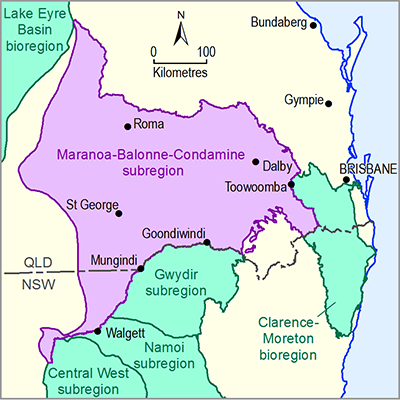- Home
- Assessments
- Bioregional Assessment Program
- Maranoa-Balonne-Condamine subregion
- 3-4 Impact and risk analysis for the Maranoa-Balonne-Condamine subregion
- 3.2 Methods
- 3.2.4 Assessing potential impacts for landscape classes and assets
- 3.2.4.3 Information for modelling and impact analysis (IMIA)
A very large number of multi-dimensional and multi-scaled datasets are used in the impact and risk analysis for each BA, including hydrological model outputs, ecological, economic and sociocultural asset data from a wide range of sources. Part of the approach used to manage these datasets and produce meaningful results is to adopt a clear spatial framework as an organising principle. While the inherently spatial character of every BA is important and must be addressed, it is also essential that the temporal and other dimensions of the analysis do not lose resolution during data processing. For example, knowing where a potential impact may take place is obviously important, but so is knowing when hydrological response variables may change, which assets may be affected, and what level of impact may result.
The datasets for this Assessment were organised into an impact analysis database (Bioregional Assessment Programme, Dataset 12) to enable efficient management. The purpose of the database is to produce result datasets that integrate the available modelling and other evidence across the assessment extent of the BA. These databases are required to support three types of BA analyses: (i) analysis of hydrological changes, (ii) impact profiles for landscape classes and (iii) impact profiles for assets.
The datasets used in the impact and risk analysis database (Bioregional Assessment Programme, Dataset 12) include the assets, landscape classes, groundwater modelling results, coal resource development ‘footprints’ and other relevant geographic datasets, such as the boundaries of the subregion, assessment extent and zone of potential hydrological change. All data in the impact and risk analysis database (and the results derived from it) meet the requirements for transparency.
The data were structured to overcome the slow geoprocessing operations typical of complex queries of very large spatial datasets, such as those required for a BA. This structuring was achieved by:
- loading as many attributes as possible into relational tables, including some spatial information such as area and length data
- simplifying and partitioning the remaining spatial data using assessment units while, importantly, retaining spatial geometries below the resolution of the assessment units.
An assessment unit is a geographic area represented by a square polygon with a unique identifier. Assessment units are non-overlapping and completely cover the assessment extent (Figure 10 and Figure 12). The spatial resolution of the assessment units is closely related to that of the BA groundwater modelling and is, typically, 1 km x 1 km. Assessment units for the Maranoa-Balonne-Condamine subregion are identical to the 1.5 km x 1.5 km OGIA model grid cells (~160,000 cells) and were extended to cover the entire assessment extent. Areas outside the OGIA regional groundwater model boundary were assumed not to be impacted and were not analysed further.
Assessment units were used to partition asset and landscape class spatial data for impact analysis. The partitioned data can be combined and recombined into any aggregation supported by the conceptual modelling, causal pathways and model data. The interpolated modelled groundwater drawdowns (see Section 3.2 .3.1) are at the same resolution as the assessment unit and contain a single value per assessment unit.
To manage issues of geospatial quality in source datasets and also technology integration, the impact and risk analysis database performed a series of geospatial operations on the source data geometry. These operations are PostGIS geometry validation, 1.0 m or less snap-to-grid, and (in some cases) 1 cm polygon buffering. The effect of these operations on area and length calculations is considered small. In general, the larger an individual geospatial feature, the smaller the relative impact and vice versa. For features with area greater than 10 km2 and length greater than 10 km, variation from source data calculations ranges between 0.0% and 0.5%. This variation may approach 40% for smaller geospatial features. These geospatial operations account for all differences in length and area that may be found when comparing data reported in this product with that in the impact and risk analysis database.

Product Finalisation date
- 3.1 Overview
- 3.2 Methods
- 3.3 Potential hydrological changes
- 3.4 Impacts on and risks to landscape classes
- 3.4.1 Overview
- 3.4.2 Landscape classes that are unlikely to be impacted
- 3.4.3 'Floodplain or lowland riverine (including non-GAB GDEs)' landscape group
- 3.4.4 'GAB GDEs (riverine, springs, floodplain or non-floodplain)' landscape group
- 3.4.5 'Non-floodplain or upland riverine (including non-GAB GDEs)' landscape group
- 3.4.6 'Human-modified' landscape group
- References
- Datasets
- 3.5 Impacts on and risks to water-dependent assets
- 3.6 Commentary for coal resource developments that are not modelled
- 3.7 Conclusion
- Citation
- Acknowledgements
- Contributors to the Technical Programme
- About this technical product
